第四板块 必修二 Modules 4 Fine Arts-Western,Chinese and Pop Arts
- 格式:doc
- 大小:95.00 KB
- 文档页数:10
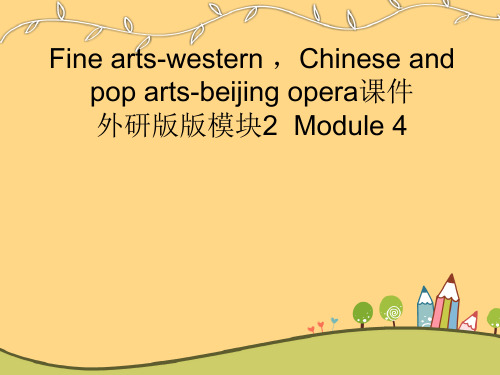
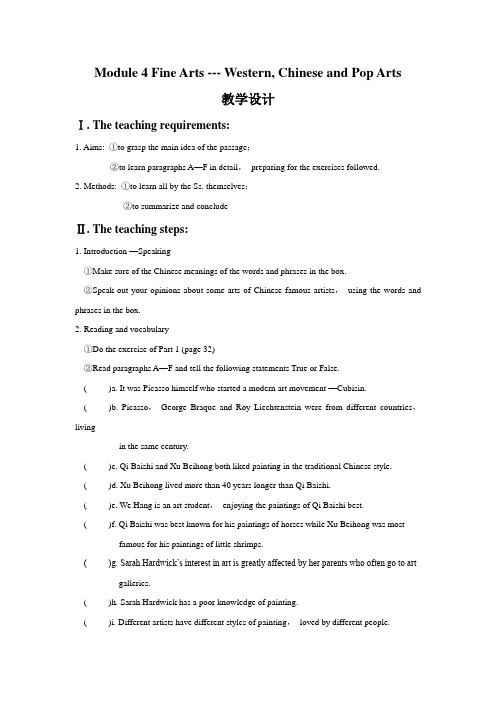
Module 4 Fine Arts --- Western, Chinese and Pop Arts教学设计Ⅰ. The teaching requirements:1. Aims: ①to grasp the main idea of the passage;②to learn paragraphs A—F in detail,preparing for the exercises followed.2. Methods: ①to learn all by the Ss. themselves;②to summarize and concludeⅡ. The teaching steps:1. Introduction —Speaking①Make sure of the Chinese meanings of the words and phrases in the box.②Speak out your opinions about some arts of Chinese famous artists,using the words and phrases in the box.2. Reading and vocabulary①Do the exercise of Part 1 (page 32)②Read paragraphs A—F and tell the following statements True or False.( )a. It was Picasso himself who started a modern art movement —Cubisin.( )b. Picasso,George Braque and Roy Liechtenstein were from different countries,livingin the same century.( )c. Qi Baishi and Xu Beihong both liked painting in the traditional Chinese style. ( )d. Xu Beihong lived more than 40 years longer than Qi Baishi.( )e. We Hang is an art student,enjoying the paintings of Qi Baishi best.( )f. Qi Baishi was best known for his paintings of horses while Xu Beihong was most famous for his paintings of little shrimps.( )g. Sarah Hardwick’s interest in art is greatly affected by her parents who often go to art galleries.( )h. Sarah Hardwick has a poor knowledge of painting.( )i. Different artists have different styles of painting,loved by different people.( )j. Chinese painting is not known for its brush drawings in black inks but mixed colors.③Fill in the blanks according to the letters given to complete the passage.Pablo Picasso,a S artist,was c as the greatest w artist of the twentieth c . He and George Braque started Cubism. Cubist artists painted o and people,with different a of the object or person s at the same time.Roy Liechtenstein,an A artist,is a world f example of p art. His paintings showed o twentieth-century city life.Qi Baishi and Xun Beihong were two examples of t Chinese painting s . Qi was famous for painting shrimps while Xu was k for his paintings of horses. Both p have a beautiful brush line. They are still loved by millions of people from generation to generation at home and abroad.1. 2. 3. 4. 5.6. 7. 8. 9. 10.11. 12. 13. 14. 15.④Write two or three sentences saying what you think about one of the paintings shown at page 31.Ⅲ、反思与小结:答案: True or False: F T T F T F T F T FFill in the blanks :1.Spanish 2.considered 3.western 4.century 5.objects 6.aspects 7.showing 8.American 9.famous 10.pop 11.ordinary 12.traditional 13.style 14.known 15.paintersModule 4 Fine-Arts—Western,Chinese and Pop ArtsPeriod II Language Points1. delightful: adj. 令人愉快的,可爱的你能参加我的生日宴会是令人高兴的,delighted: adj. 高兴的、愉快的,指自己感到高兴的。
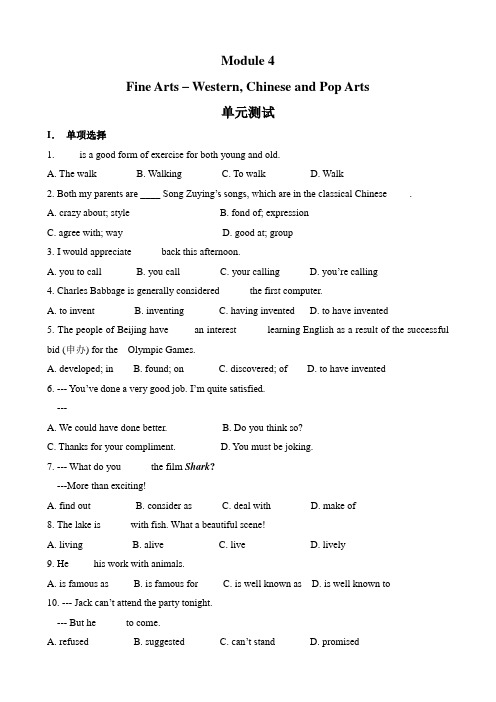
Module 4Fine Arts – Western, Chinese and Pop Arts单元测试I.单项选择1. ____ is a good form of exercise for both young and old.A. The walkB. WalkingC. To walkD. Walk2. Both my parents are ____ Song Zuying’s songs, which are in the cla ssical Chinese ____.A. crazy about; styleB. fond of; expressionC. agree with; wayD. good at; group3. I would appreciate _____ back this afternoon.A. you to callB. you callC. your callingD. you’re calling4. Charles Babbage is generally considered _____ the first computer.A. to inventB. inventingC. having inventedD. to have invented5. The people of Beijing have ____ an interest _____ learning English as a result of the successful bid (申办) for the Olympic Games.A. developed; inB. found; onC. discovered; ofD. to have invented6. --- You’ve done a very good job. I’m quite satisfied.--- _______A. We could have done better.B. Do you think so?C. Thanks for your compliment.D. You must be joking.7. --- What do you _____ the film Shark?---More than exciting!A. find outB. consider asC. deal withD. make of8. The lake is _____ with fish. What a beautiful scene!A. livingB. aliveC. liveD. lively9. He ____ his work with animals.A. is famous asB. is famous forC. is well known asD. is well known to10. --- Jack can’t attend the party tonight.--- But he _____ to come.A. refusedB. suggestedC. can’t standD. promised11. After years of hard work, his dream has ______.A. realizedB. become a realityC. turned into realitiesD. been realistic12. Considering it a bad influence on her, the teacher found an excuse for ___ telling her the news.A. putting offB. succeed inC. look forward toD. be fond of13. Kids can suddenly get very tired _____ together for no reason.A. of playingB. to playC. after playingD. in playing14. --- What do you enjoy most in life?--- ______. It’s really good fun.A. Good friends.B. Spending time with good friends.C. To spend time with good friendsD. I spend time with good friends.15. ______, when he was already ______, he started to learn painting.A. In the 1980; thirtiesB. In the 1980’s; in his thirtiesC. In the 1990; in thirtiesD. In 1990’s; in his thirtiesII. 完形填空阅读下面短文,掌握其大意,然后从各题给的四个选项(A.B.C和D)中,选出最佳答案.Making friends is a skill like most skills. 1 improves with 2 . If you want to make friends, you must be 3 to take some action. You must first go 4 there are people. You won't make friends staying home 5__.Join a club or group, talking with those who like the 6 things as you do is much easier. Or join someone 7 some activity.Many people are 8 when talking to new people. 9 all, meeting strangers means seeing the 10 . And it's human nature to feel a bit 11 about the unknown.Most of our fears about dealing 12 new people comes from doubts about 13 .We imagine other people are 14 us--finding too short, too this or too that. But don't forget that they must be feeling the same way. Try to accept yourself 15 you are, and try to put the other person at ease. You'll both feel more 16__.Try to act self-confident (自信) even 17 you don't feel that way when you enter a room full of 18 such as a new classroom, walk tall and straight,1ook 19 at other people and smile. If you see someone you'd like to , say something. Don't wait for the other person to start a conversation.1. A. They B. It C. Which D. He2. A. practice B. time C. experiences D. knowledge3. A. likely B. possible C. willing D. satisfied4. A. where B. there where C. to the place D. the place5. A. lonely B. yourself C. with yourself D. alone6. A. familiar B. different C. same D. opposite7. A. with B. in C. on D. to8. A. excited B. frightened C. worried D. nervous9. A. At B. For C. In D. After10. A. new B. old C. unknown D. strange11. A. unhappy B. unusual C. uncomfortable D. shyness12. A. with B. to C. for D. on13. A. yourself B. herself C. yourselves D. ourselves14. A. talking B. saying C. judging D. laughing at15. A. like B. as C. what D. that16.A. familiar B. similar C. comfortable D. nervous17. A. when B. if C. as D. what18. A. teachers B. students C. strangers D. friends19. A. upwards B. directly C. bravely D. happilyA. speak toB. talk aboutC. say toD. call upIII。
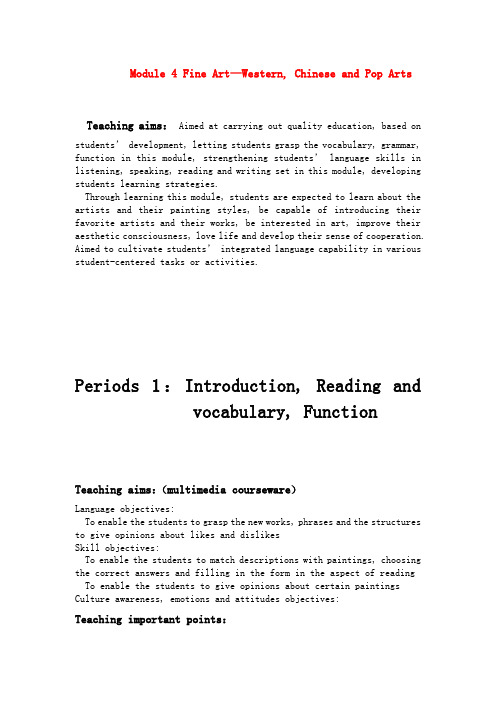
Module 4 Fine Art—Western, Chinese and Pop ArtsTeaching aims: Aimed at carrying out quality education, based onstudents’development, letting students grasp the vocabulary, grammar, function in this module, strengthening students’ language skills in listening, speaking, reading and writing set in this module, developing students learning strategies.Through learning this module, students are expected to learn about the artists and their painting styles, be capable of introducing their favorite artists and their works, be interested in art, improve their aesthetic consciousness, love life and develop their sense of cooperation. Aimed to cultivate students’ integrated language capability in various student-centered tasks or activities.Periods 1:Introduction, Reading andvocabulary, FunctionTeaching aims:(multimedia courseware)Language objectives:To enable the students to grasp the new works, phrases and the structures to give opinions about likes and dislikesSkill objectives:To enable the students to match descriptions with paintings, choosing the correct answers and filling in the form in the aspect of reading To enable the students to give opinions about certain paintings Culture awareness, emotions and attitudes objectives:Teaching important points:To enable the students to speak out opinions about some paintings with some expressionsTo enable the students to grasp the new works and phrases in this part Teaching procedures: PWP Teaching ModelStep1. leading-in activityUse the paintings The Smile of Mona Lisaby da Vinci and the works by Zheng Banqiao on the screen to lead in the topic.Meanwhile, I will introduce the key new words: artist, paint, traditional, brush, ink.Step 2. While—reading1)ScanningDuring the start of the period, let the students scan the passage to find out the answers to the questions on Page32, which are about the topics.⑴Match paintings 1-4 with descriptions in paragraphs A-D.⑵Say which paintings are mentioned in paragraph E and F.2)Detailed readingDuring this period, I’ll allow students enough time to read the text and then I let them work in groups to do the following two tasks:⑴Do the multiple choices on the screen.⑵Fill in the form on the screen, which is mainly about the famous artists.3)Language points⑴consider 认为①This is a painting by the Spanish artist, Pablo Picasso, and he is considered to be the greatest western artist of the twentieth century.This is a painting by the Spanish artist, Pablo Picasso, ____ ____ ____ the greatest western artist of the twentieth century.②We consider that his advice is helpful.We consider his advice ____ ____ helpful.③She __________________(被认为是个可爱的孩子).⑵with复合结构①Cubist artists painted objects and people, and different aspects of the object or person showed at the same time.Cubist artists painted objects and people, ___ different aspects of the object or person ____ at the same time.②He had so much work to do, he was kept as busy as a bee.____ so much work ____ ____, he was kept as busy as a bee.③I felt a bit nervous because so many people were watching me soI felt a bit nervous, ____ so many people ____ me so closely.④Because his homework had been finished, he went out to play.____ his homework ____, he went out to play.⑤He went to sleep, with the door open.He went to sleep, and ____ ____ ____ ____.⑥Tom came in, and there was a baseball bat in his hand.Tom came in, with a baseball ____ ____ ____.⑶aim 以…为目标;意欲;打算①Pop art (from the word “popular”) was an important modern art movement that attempted to show ordinary twentieth-century city life. Pop art (from the word “popular”) was an important modern art movement that ____ ____ show ordinary twentieth-century city life.②Our aim is to start and run our own company.We ____ ____ start and run our own company.③I’m aiming at losing 4 kg before the summer holidays.I ____ ____ ____ lose 4 kg before the summer holidays.⑷stand 忍受①I don’t like that picture of a golden-haired girl.I can’t ____ that picture of a golden-haired girl.②We have to put up with her bad temper.We have to ____ her bad temper.③I can’t stand working in the extreme heat for several hours.(英译汉)_________________________________________________⑸I got bored of looking at pictures all the time.I ____ ____ ____ looking at pictures all the time.⑹Tom gradually became interested in art.Tom ____ ____ ____ ____ art.Step3. Post—readingDuring this period, I’ll let the students do the following tasks.⑴Find out the structures that can be used to giving opinions about likes and dislikes from the paragraphs E and F individually.⑵And then, along with the students, I’ll look through the sentences giving opinions, provided in the first part of Function, making sure that they know how to express likes and dislikes. Show the students a series of paintings on the screen, letting them in groups talk about the pictures they like and dislike, and why or why not, using the information learned from the reading material(or in the form of interviewing—group work).Step4. HomeworkTry to find more paintings and artists you like through the Internet. Prepare to introduce a painting in English to your classmates next(The day students are assigned to the first task; and the rest of the students to the second.)Blackboard design:Module 4 Fine arts—Western, Chinese and Pop Arts Period One consider: consider sb./sth. to be adj./n.with复合结构: with+宾语+宾补(adj./adv./prep. Phrase/-ing/-ed/inf.)aim v./n. aim to do sth. aim at doing sth.stand+n./doing sth.get tired of/get bored of “厌烦……”develop an interest in“养成对……的兴趣”Teaching reflection:In the process of leading in, students arefamiliar with the paintings and the artists, so the pictures can easily arouse their interest and desire to participate. In the process of while-reading, pay attention to the developing of students reading strategies. In the process dealing with language points, setting the new words in a context helps the students learn and comprehend the meaning and the usage of them. In the discussion about their favorite paintings, some students are reluctant to speak, partly because of their lack of knowledge of painting; most students can communicate with their partners or group members after learning the reading materials. The task of assignment is set for the sake of the second period, that is, Listening and vocabulary, to some extent.Periods 2:Listening and vocabulary,Everyday English, SpeakingTeaching aims:To enable the students to grasp the new words in the listening material. To enable the students to comprehend and put to use the everyday English in the listening material.Skill objectives:To enable the students to follow the listening material about artists and art works, which has similar difficulty to the reading material, and identify opinions.To enable the students to pay attention to the weak sound and read correctly.Teaching important points:To enable the students to follow the listening material about artists and art works, which has similar difficulty to the reading material, and identify opinions.To enable the students to pay attention to the weak sound and read correctly.To enable the students to give opinions about certain paintings Teaching procedures: PWP Teaching ModelStep1. Pre-listening⑴ Show some pictures on the screen;:that is, a watercolor, an oil painting, a portrait, a landscape, an art gallery.Through showing the pictures, I, together with the students study the new words,( watercolor, oil painting, portrait, landscape, art gallery), letting them pay attention to the pronunciation and the weak sounds/unstressed syllables of the words.⑵Then I’ll let the students in pairs learn the meaning of the new words in the contexts, in the form of completing the sentences with them (Part1, Page36), after reading after me.Step2. While-listening⑴Before listening, ask the students to look at the two pictures on Page36 and find out some similarities and differences. Listen for the first time, and answer the following questions:①What are the boy and girl are discussing?②Which picture is the boy painting, Picture1 or Picture2? Say how you know this.③Why does the girl say sorry at the end of the conversation?⑵Detailed listening/Pair workListen to the conversation again, and complete the following sentences. First let the students check their answers with their partners; then I’ll play the recording again for them to check; and then I’ll checkthe answers with the class.Then I ’ll show the following sentences on the screen:①You ’ve got it right.②Don ’t change a thing.③I ’m not half as good as you.④What do you make of it?⑤There ’s (an exhibition) on.⑥Thanks for the compliment.This time I ask the students to think about the meaning of the sentences after listening to the recording again, and then do the exercise on Page38 (Part1) in pairs. Then collect the answers from the whole class. Step3. Post-listening⑴Let the students describe the Picture2 on Page36 in pairs. ⑵Act the dialogue out in pairs.⑶Make up dialogues using the everyday English learned from the listening material.Step4. Homework⑴Look through the Cultural Corner and collect some works of Pablo Picasso or information about him on the Internet.⑵ Look through the Cultural Corner and tell which picture below belongs to the “pink period ”, Which one do you like best? Which do you like least? And give your opinions about the pictures.2 3The day students are assigned to the first task; and the rest of the students to the second task.Teaching reflection :At the start of the period, using the pictures to introduce the some of the new words in the listening material can arouse students ’ interest and reduce the difficulty students have in listening to the material. Similarly, letting students look at the two pictures on Page36 and find out some similarities and differences can arouse their curiosity and reduce the difficulty of Question-- Which picture is the boy painting, Picture1 or Picture2? Say how you know this. In the process of while-listening, After showing the six sentences taken from the recording on the screen, then let students listen to the recording while listening to the recording, which helps students comprehend the everydayEnglish according to the context. In the process of post-listening, the task of making up dialogues in pairs strengthen students’ cooperation in one aspect; meanwhile, students can grasp the usage of the everyday English. The task of assignment is set to make students learn more about art and artists and provides more chances for students to practice giving opinions. On the other hand, it is for the transition to the grammatical learning in the next period.Periods3:Grammar1 & Grammar 2and VocabularyTeaching aims:To enable the students to grasp the usage of –ing form acting as subjects and objects and the infinitive acting as objects.To enable the students to grasp the usage of the new words and phrases. Skill objectives:To enable the students to understand the grammatical function of –ing form and the infinitive.Teaching important points:To enable the students to grasp the usage of –ing form acting as subjects and objects and the infinitive acting as objects.To enable the students to grasp the usage of the new words and phrases Teaching procedures: PWP Teaching ModelStep1. RevisionI’ll let some volunteers show their works about of Pablo Picasso or information about him on the Internet.Step2. Leading-in/PresentingI’ll show a series of sentences containing –ing form or the infinitive acting as subjects or objects on the students learning plan. And then let the students in groups discuss similarities and differences between the sentences and classify them according to their characteristics. Group One(verbs/verbal phrase + the infinitive as objects):1) attempt;2)promise; 9)aim; 10)pretend; 11)happen; 12)agreeGroup Two(verbs/ phrase + –ing form as objects): 4) suggest; 7)stand;13)put off; 14).give up;3)be fond of; 8)get tired ofGroup Three(verbs/verbal phrase + –ing form as objects/ the infinitive as objects): 15),16) go on; 17),18)mean; 19),20)likeGroup Four (-ing form as subjects): 5)painting; 6)copying a picture;17)being lateThen let the students continue discussing in groups and then give them a listing task, that is, adding as many verbs or phrases as they can to Groups1-3.Group One只能用不定式作宾语的动词:refuse, promise, pretend, wish, hope, agree, ask, decide, expect, manage, offer, afford, agree, ask ,beg, care, choose, dare, desire, determine , fail, learn , prepare, plan, long, happen, seem…Group Two只能用v-ing 形式作宾语的动词或短语:admit, avoid, appreciate, keep, consider, delay, enjoy, escape, excuse, finish, imagine, mention, mind, miss, practice, permit, risk ,suggest, advise, allow, permit…feel like, give up, put off , can’t help (禁不住), can’t stand (无法忍受) , be busy in, be worth, lead to, look forward to, devote...to, stick to, be used to, get down to, object to, pay attention to…Group Three1)能用不定式又能用v-ing 形式,并且意义差异不大的动词:prefer,continue, like, hate, love2)既可接不定式又可接v-ing 形式,但含义不同的动词有:remember, forget,try, go on, mean, regret…Step3. Practice1.— You were brave enough to raise objections at the meeting .— Well , now I regret _____ that .A. to doB. to be doingC. to have doneD. doing2.The squirrel was so lucky that it just missed ____.A. catchingB. being caughtC. to be caughtD. to catch3.The teacher doesn’t permit ____ in class.A. shoutingB. shoutC. to shoutD. having shouted4. —What makes you so happy?— ____.A. Passing the driving testB. Because I’ve passed the driving testC. For passing the driving testD. Pass the driving test5.I forgot _____ (buy) the book, so I have to borrow one.6.Please remember____ (turn off) the light when you leave.7.Try _____ (knock) at the back door and see whether he is in or not.8.We must try ____ (come) here as early as possible.9.What do you mean ___ ( do) with it?10.I won’t stay if it means ____(listen) to another dull talk.【速记口诀】同意提出学会的打算,要求答应来帮忙。
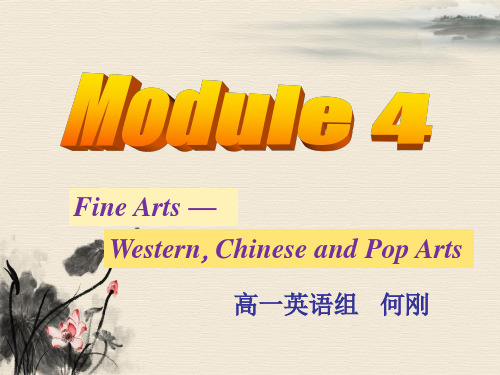

模块质量测评(四)Module 4Fine Arts — Western,Chinese and Pop Arts(时间:90分钟满分:110分)第一部分阅读理解(共两节,满分30分)第一节(共10小题,每小题2分,满分20分)阅读下列短文,从每小题后所给的A、B、C、D四个选项中,选出最佳选项。
AI was driving down a quiet country road and heading home. As I was rounding a bend, I saw a rock in the middle of the road. As I slowed to go around it, I noticed that it had a head and was staring up (抬头注视) at me. It was a turtle who had decided to warm up by sunbathing on the road.I pulled over to the side of the road and picked up the sunbather. I knew if I moved the turtle off to the side of the road he would just crawl (爬行) back to the warmer spot as soon as I left. Not knowing what else to do then I carried him to my car and placed him on the passenger seat.When I finally made it home, I picked up the sunbather again and headed to the woods behind my house. After looking around a bit I saw a clear spot where the sun was shining down on a single rock. I gently placed the turtle down on it and took a few steps back. A few minutes later the head slowly came out and started enjoying the sun once more. I smiled and headed back to my house. My simple act of kindness may not have seemed like much in the eyes of the world, but it made a difference in the life of one turtle and in the heart of one man.Most of us go through our lives wanting to make some big difference in this world. However, any kind act makes a difference. Remember this the next time you see a person or a turtle needing a helping hand.语篇解读一只乌龟在公路上晒太阳,作者担忧它的平安,把它带回到家放到屋后的小树林,让它在那里平安地享受阳光的沐浴。
Ⅰ.单项填空1.—Did you watch the football game on TV last night?—Yes,I did.It was________,and I enjoyed every minute of it.A.alive B.liveC.living D.lively2.The boy________a great interest in natural science at school.A.developed B.inventedC.made D.discovered3.Nancy is________dancing,and she keeps dancing till midnight every day.A.curious about B.crazy aboutC.anxious for D.concerned about4.He is a man of strong self-respect,so he can’t stand________in public.A.laughing at B.being laughed atC.laughed at D.having been laughed at5.Alice’s father had her________because he couldn’t look after her himself.A.raised B.fedC.supported D.adopted6.Lydia really regrets________out of high school.She has really had to struggle to make a living because of that decision.A.drop B.to dropC.dropping D.dropped7.—I’ve been told the sports meet might be________.—Yes,it all depends on the weather.A.put away B.put outC.put off D.put up8.Mr Smith was almost broken down by________unfortunate events that happened to him.A.a range of B.a variety ofC.a series of D.a list of9.Limited natural resources should be made full use of________the ________need of energy.A.meeting;increasing B.to meet;increasedC.meeting;increased D.to meet;increasing10.After many years of hard work,his dream was finally________.A.come true B.realizingC.coming true D.realized11.The energy Jenny Bowen has devoted in the past ten years________the orphans has been considered________of great value.A.to help;being B.to helping;to beC.to help;to be D.helping;being12.—Go for a picnic this weekend,OK?—________.I love getting close to nature.A.I couldn’t agree more B.I’m afraid notC.I believe not D.I don’t think so13.I could________by the way she walked that her knee was still bothering her.A.tell B.separateC.divide D.find14.—Most of the apples in the bag have gone bad.—Yes,only three are good.The rest________gone rotten.Just now I ate part of a big one,and the rest________thrown away.A.has;was B.have;wereC.have;was D.has;were15.It was between 1830 and 1835________the modern newspaper was born.A.what B.whichC.because D.thatⅡ.句子翻译16.这次访问的目的是发展两国关系。
教师学科教案[ 20 – 20 学年度第__学期]任教学科:_____________任教年级:_____________任教老师:_____________xx市实验学校Module 4 Fine Arts — Western, Chinese and Pop Arts I.模块教学目标II. 目标语言Ⅲ. 教材分析与教材重组1. 教材分析本模块是围绕Fine Arts —Western, Chinese and Pop Arts 而设计的。
教材以此为中心,设计和组织各项活动,如组织学生参观当地的艺术展览馆或博物馆、采访学校的艺术教师或邻近社区的艺术家,让学生用英语介绍所见所闻,在活动中提高学生的语言表达能力,同时也培养他们的文化意识以及热爱家乡和艺术的情感。
1.1 INTRODUCTION 部分为全模块的热身部分,列出了与艺术有关的词汇,并设计了两个练习活动,学生可以初步熟悉这些词的意义,为以后的各项学习活动做好准备。
1.2 READING AND VOCABULARY部分课文由六个段落组成,分别介绍了毕加索等数位世界级著名艺术家及其艺术风格。
围绕课文,编者设计了三个练习。
通过这些练习,学生可以熟悉课文内容,学会使用与艺术家和艺术作品有关的词汇。
1.3 FUNCTION部分列出了交际中表达意见的语句,要求学生就自己喜欢的和不喜欢的艺术作品发表自己的观点。
1.4 GRAMMAR 1 部分围绕动词的-ing形式和to do形式作宾语这一语法内容设计了一系列练习,旨在让学生掌握动词的-ing形式和to do形式作宾语的用法区别。
1.5 LISTENING AND VOCABULARY 部分有两项任务,一是词汇练习,为听力活动做好铺垫。
二是听录音,然后完成与录音内容相关的练习。
1.6 GRAMMAR 2 部分主要练习动词的-ing形式做主语这一语法内容。
第一个练习让学生熟悉每个句子中的-ing形式;第二个练习用动词的-ing形式完成句子,以巩固所学内容。
第四板块 必修二 Modules 4 Fine Arts-Western,Chinese and Pop Arts [高考对接题] 语音知识(陕西专用)(建议用时2′) 1.scene A./sIn/ B./seIn/ C./ D./sen/ 答案:C 2.destroy A./dI'strɔI/ B./dI'stʃɔI/ C./dI'sdʒɔI/ D./dI'strɔI/ 答案:D 3.celebrity A. B./seI'lebrəti/ C./se'lebrəti/ D./sə'lebrəti/ 答案:D 4.congratulation A. B. C. D. 答案:D 5.female A. B./'feImeIl/ C./'fImeIl/ D./'femIl/ 答案:A Ⅰ.单项填空(建议用时8′) 1.(2010·安徽合肥八中模拟)A government should permit the free ________ of political opinion. A.expression B.impression C.pressure D.depression 解析:考查名词辨析。expression“表达”。句意:一个政府应该允许自由表达政 治见解。impression“印象”;pressure“压力”;depression“萧条”,均不符合 题意。 答案:A 2.(2010·哈尔滨第九中学模拟)Whenever it is,it is right for a student to ________ the school disciplines. A.see B.watch C.notice D.observe 解析:考查动词辨析。句意:不管何时,学生都应该遵守学校的纪律。see“看 到”;watch“观察”;notice“注意到”;observe“观察,遵守”。 答案:D 3.(2010·江苏如皋中学模拟)All the staff in our company are considering ________ to the city centre for the fashion show. A.to go B.going C.to have gone D.having gone 解析:句意:我们公司所有的员工正打算去市中心观看时装表演。consider作“考 虑,打算”讲,后跟动名词形式,排除A、C;又由are considering 可知打算做的 事情还没有发生,排除D。 答案:B 4.(2009·山东潍坊一模)There is nothing more I can try ________ you to stay,so I wish you good luck. A.persuading B.being persuaded C.to be persuaded D.to persuade 解析:句意:我没有办法劝你留下来,所以只能祝你好运。第一个分句的主句部 分为There is nothing more,其余部分为定语从句,先行词是nothing more,将先 行词代入定语从句后为:I can try nothing more ________ you to stay,由此可知此 空处应该用不定式表目的。 答案:D 5.(2010·江苏南通调研)Don't deny it.I can tell ________ your writing. A.about B.against C.by D.on 解析:句意:别否认,我能从你的笔迹辨别出来。tell by“从„„辨别出”;tell about“讲述”;tell against sb.“对某人不利”;tell on sb.“告发某人,告某人的 状”。 答案:C 6.(2010·辽宁大连二十四中模拟)The factory must aim ________ new models of machine. A.to developing B.at developing C.to be developing D.to be developed 解析:aim at doing...或aim to do...表示“目的是„„,目标是„„”。句意:工厂 必须致力于研发新型的机器。 答案:B 7.I can't stand ________ with Jane in the same office.She just refuses ________ talking while she works. A.working;stopping B.to work;stopping C.working;to stop D.to work;to st op 解析:句意:我不能容忍跟简在一个办公室里工作,她工作时不停地说话。Stand 作“容忍”时后接动名词作宾语;refuse to do “拒绝做某事”。 答案:C 8.—It's so kind of you to do such for me. —________. A.Yes,I think so B.I'm afraid not C.I don't think so D.Don't mention it 解析:Don't mention it 意思是“不用客气”用于回答别人的感激或感谢之言。 答案:D 9.He moved to a foreign country,where he had to ________ himself to the new customs and habits. A.adapt B.adopt C.fit D.suit 解析:考查动词的用法。句意:他搬到了国外,在那里他不得不适应新的风俗习 惯。adapt oneself to...“使自己适应„„”;adopt“收养,采纳”;fit“适合”; suit“(服装样式等)适合”。 答案:A 10.When the fire broke out,the old man who had been living ________ was able to get out of the burning building ________. A.alone;living B.alone;alive C.alone;live D.lonely;living 解析:live alone “一个人独居”,alone副词作状语,故排除D,后一个空所缺内 容为主语补足语,表示“活着的”,故只能用alive。 答案:B 11.The young man, ________ several attempts to beat the world record in high jumping,decided to have another try. A.to make B.making C.made D.having made 解析:句意:这位年轻人曾几次试图打破跳高的世界纪录但未如愿,他决定再试 一次。本题考查非谓语动词作状语,主句主语与非谓语动词存在逻辑上的主动关系,排除C项;不定式表将来或目的,排除A项;make several attempts在decided之前,故用现在分词的完成式形式,故选D项。 答案:D 12.________in a well-known university is what everybody wishes for. A.Educated B.Being educated C.To educate D.Educating 解析:由句子结构可知,空格处缺少的是主语,这样排除A项,另外educate与 题中的everybody 是被动关系,故用动名词的被动形式,选B。 答案:B 13.Isn't it time you got down to ________ the papers? A.mark B.be marked C.being marked D.marking 解析:get down to doing sth.“开始做„„,着手做„„”,其中 to 是介词。 答案:D 14.It's not any use ________ such a thing. A.doing B.to do C.done D.do 解析:It's not any use doing sth.“做„„是没有任何用处的” 是固定句型,故选 A。 答案:A 15.What worried the boy most was ________ to visit his father in the hospital. A.his not allowing B.his not being allowed C.his being not allowed D.having been not allowed 解析:考查非谓语动词的否定形式。否定词 not 置于非谓语动词前,动词 allow 与 the boy 之间是被动关系,所以选B。 答案:B Ⅱ.完形填空(难度系数★★,建议用时17′) Cervasio never saw it coming.Her son Angelo,24,__1__ drank,never used drugs,and didn't seem to have any sign of __2__. Then,not long after midnight on January 17,2006,policemen rang Cervasio's